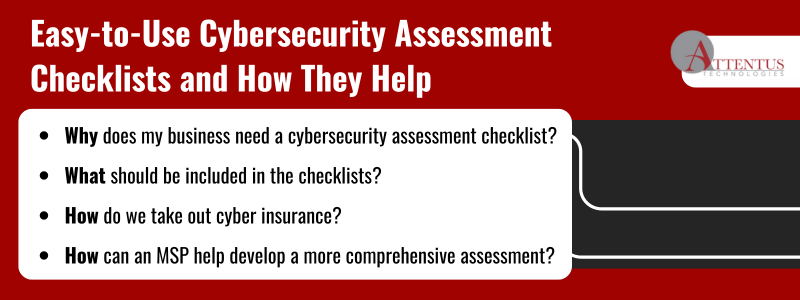To keep your organization safe, you need to develop cybersecurity assessment checklists, making sure you have all the required protocols in place

Most small and medium businesses (SMBs) realize the importance of taking cybersecurity precautions. They know they are bound to be targeted by hackers sometimes since these types of companies usually lack the resources of larger corporations to deal with such crimes.
But the challenge becomes, how do you cover all your bases? Statistics show that most organizations have blind spots in their security precautions. McKinsey and Company points out, “A common challenge for smaller companies is that leaders understand the importance of risk and cyber oversight but are uncertain about how to build and manage the required capabilities.”
One way to ensure that you have a robust selection of precautions in place is to use cybersecurity checklists that cover everything from incident report planning to firewall protections to employee training. By methodically reviewing these checklists, you can reduce your areas of vulnerability
Here are a few cybersecurity assessment checklists to set up the protocols to secure your business.
Why do you need a cybersecurity assessment checklist?
A cybersecurity assessment checklist is a simple way to track what you need to do to protect your sensitive information. Checklists provide a methodical approach to planning and security that can help:
- Mitigate risks and prevent errors
- Improve organization and efficiency
- Standardize processes and ensure quality
- Enhance focus and priorities
It’s also an effective reference tool that explicitly states what you have and do not have in your cybersecurity plan. I.T. teams can also use cybersecurity checklists to identify vulnerabilities before they’re exploited. You should regularly assess your systems to detect hidden or persistent problems.
What should be on your cybersecurity assessment checklist?
Every cybersecurity checklist should include these basic elements:
- Password protocols
- Multi-factor authentication (MFA)
- Incident response planning
- Safe mobile practices
- Firewall protection
- Antivirus software
- Employee training
But you’ll have to go beyond the basic security precautions to qualify for cyber insurance — which is always a good idea. According to IBM Security’s 2023 Cost of a Data Breach Report, the average data breach cost hit a record high of $4.45 million in 2023, representing a 2.25% increase from 2022. With cyber insurance coverage, you can get help paying for those costs.
You will need the following precautions to qualify for cyber insurance in the U.S.:
- A managed service provider (MSP)
- EDR (endpoint detection response)
- MDR (managed detection and response)
- Cloud data backup and recovery plans
- Vulnerability management
- Multiple data backups
- Data detection and data loss prevention (if you’re dealing with sensitive data)
- Everything listed on our recommended basic list
Cybersecurity audit checklist
This cybersecurity audit checklist is designed for your I.T. professionals. It lists questions to answer as they inspect your system. If there are issues, they can recommend how to patch them.
Common questions to ask include:
|
|
Recommendations: |
Cybersecurity risk assessment checklist
The cyber threat assessment checklist detects potential vulnerabilities, identifies threats, and assesses their possible consequences.
In this chart, your team can write their findings in the left-hand column and check how they may impact your organization on the right.
|
Threat or Vulnerability |
Potential Risks |
|
|
|
|
|
|
|
|
|
|
|
|
|
Recommendations: |
|
Threats could include malicious human interference, such as distributed denial-of-service (DDoS) attacks, system failure, and accidental human interference, such as mistaken file deletion. Threats can also be rated with high-, medium-, and low-risk assessments. You can also take this checklist a step further, adding a column for the financial and productivity consequences of a threat and one for solutions to the problems.
Information security risk assessment checklist
An information security assessment analyzes how well you’re protecting your data. It can help you understand the risks you face to strategically improve your procedures, processes, and technologies to reduce the chances of business disruptions and financial losses.
You should ask essential questions such as:
|
|
Recommendations:
|
Threat assessment checklist for cybersecurity
This checklist helps you inspect potential threats in your I.T. system. You can also categorize them as “low,” “medium,” or “high” severity. Severity depends upon how much the potential threat will impact your business in the worst-case scenario. The higher the severity, the more protection you should have.
|
Human Error (i.e. lack of training, poor enforcement of standards) |
||
|
|
|
|
Privacy Concerns (i.e. spyware, lack of access control) |
||
|
|
|
|
Malware (i.e. viruses, adware) |
||
|
|
|
|
Data Integrity (i.e. lost or misrecorded information) |
||
|
|
|
|
Legality (i.e. repercussions for failing to meet regulatory compliance) |
||
|
|
|
|
Recommendations: |
||
Enhance your cyber-risk assessments with help from the experts
This guide only scratches the surface of the cybersecurity problems you may face and the solutions you need. For full protection, you must examine your specific security needs more thoroughly. Your business practices or industry standards can make a big difference.
This is a big job for any organization to take on. You need a reliable managed services provider (MSP) like Attentus Technologies. We offer expert cybersecurity consulting services that will take your security controls to the next level. With over 20 years of I.T. and cybersecurity experience, you can rest assured that we can help you check all the necessary boxes on your cybersecurity risk assessment.
Let’s collaborate to assess the likelihood of a breach and craft the perfect protection and recovery plan for you. Contact us to learn more. You’ll be happy that you checked that off your to-do list.

